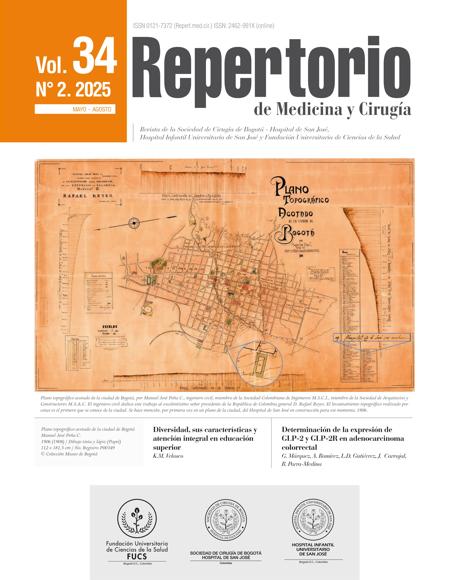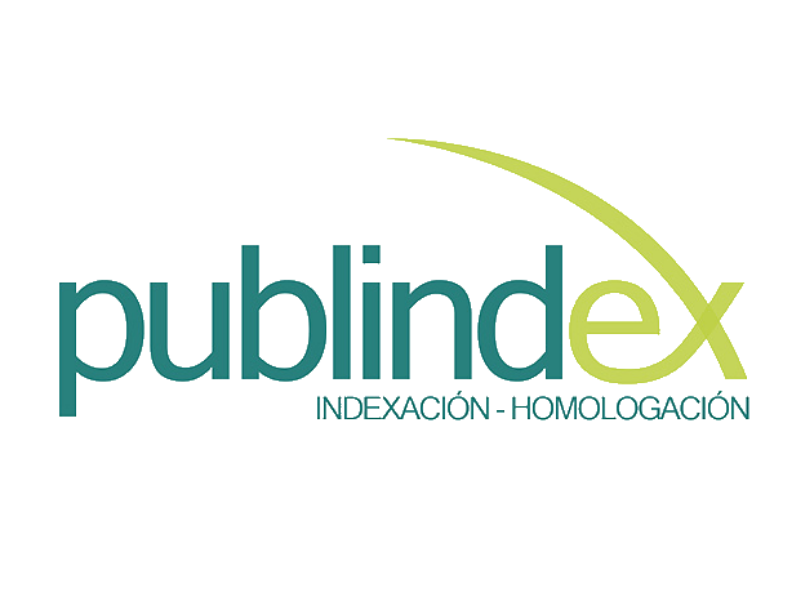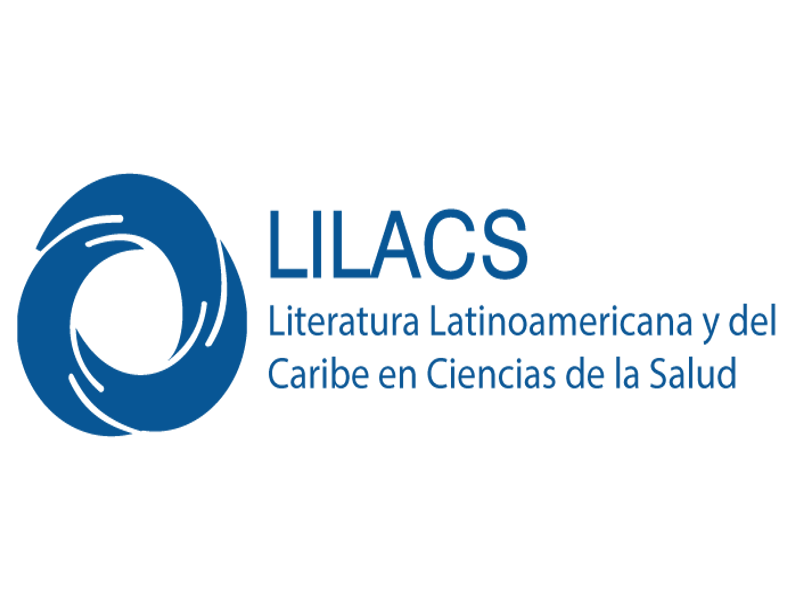Determination of GLP-2 and GLP-2R expression in colorectal adenocarcinoma
Determinación de la expresión de GLP-2 y GLP-2R en adenocarcinoma colorrectal
![]()
![]()

Show authors biography
Introduction: the function of neuroendocrine peptides such as GLP-2 and its receptor has been associated with the development of colorectal carcinoma (CRC). This peptide promotes intestinal epithelial growth through the liberation of substances stimulating tumor cells, such as muscle fibroblasts, proliferation, migration and invasion, favoring CRC development. Objective: to analyze GLP-2 and GLP-2R amplification in tissue samples of patients diagnosed with CRC. Materials and Methods: paraffin embedded samples obtained from patients diagnosed with colon adenocarcinoma, between 2016 and 2020, at Hospital de San José and Infantíl Universitario de San José in Bogotá DC, evaluating GLP-2 and GLP-2R expression using the qPCR assay and immunohistochemistry. Results: the study included a population of 50 patients diagnosed with CRC, 80% featured a classical moderately differentiated adenocarcinoma; qPCR testing showed GLP-2 and GLP-2R amplification in 4 samples (8%) of moderately differentiated adenocarcinomas. Conclusions: the relationship between GLP-2/GLP-2R expression and CRC remains unclear. Studies in animal models have reported that GLP-2 and GLP-2R expression are related to CRC development, while studies in humans, including the present study, have not demonstrated a direct relationship between GLP-2 and GLP-2R and the development of CRC.
Article visits 384 | PDF visits 82
Downloads
- Bray F, Laversanne M, Sung H, Ferlay J, Siegel RL, Soerjomataram I, Jemal A. Global cancer statistics 2022: GLOBOCAN estimates of incidence and mortality worldwide for 36 cancers in 185 countries. CA Cancer J Clin. 2024;74(3):229-263. https://doi.org/10.3322/caac.21660
- Baracaldo Ayala, RL, Peña Carvajalino LF, Gómez Rodríguez O, Nieto JFP, López Correa P, Medina RP. Características histopatológicas del carcinoma colorrectal con inestabilidad microsatelital (IMS). Repert Med Cir. 2020;29(1):32-40. https://doi.org/10.31260/RepertMedCir.v29.n1.2020.172
- Gunawardene AR, Corfe BM, Staton CA. Classification and functions of enteroendocrine cells of the lower gastrointestinal tract. Int J Exp Pathol. 2011;92(4):219-231. https://doi.org/10.1111/j.1365-2613.2011.00767.x
- Parra-Medina R, Moreno-Lucero P, Jimenez-Moreno J, Parra-Morales AM, Romero-Rojas A. Neuroendocrine neoplasms of gastrointestinal tract and secondary primary synchronous tumors: A systematic review of case reports. Casualty or causality? PLoS One. 2019;14(5):e0216647. https://doi.org/10.1371/journal.pone.0216647
- Ramírez-Perdomo A, Márquez-Barrios G, Gutiérrez-Castañeda LD, Parra-Medina R. Neuroendocrine peptides in the pathogenesis of colorectal carcinoma. Exp Oncol. 2023 Jun 26;45(1):3-16. https://doi.org/10.15407/exp-oncology.2023.01.003
- Kannen V, Garcia SB, Stopper H, Waaga-Gasser AM. Glucagon-like peptide 2 in colon carcinogenesis: Possible target for anti-cancer therapy? Pharmacol Ther. 2013;139(1):87–94. https://doi.org/10.1016/j.pharmthera.2013.04.007
- Pedersen J, Pedersen NB, Brix SW, Grunddal KV, Rosenkilde MM, Hartmann B, Ørskov C, Poulsen SS, Holst JJ. The glucagon-like peptide 2 receptor is expressed in enteric neurons and not in the epithelium of the intestine. Peptides. 2015;67:20-8. https://doi.org/10.1016/j.peptides.2015.02.007
- Lu Y, Kweon S-S, Tanikawa C, Jia W-H, Xiang Y-B, Cai Q, et al. Large-Scale Genome-Wide Association Study of East Asians Identifies Loci Associated With Risk for Colorectal Cancer. Gastroenterology. 2019;156(5):1455–66. https://doi.org/10.1053/j.gastro.2018.11.066
- Burrin DG, Stoll B, Guan X, Cui L, Chang X, Holst JJ. Glucagon-Like Peptide 2 Dose-Dependently Activates Intestinal Cell Survival and Proliferation in Neonatal Piglets. Endocrinology. 2005;146(1):22–32. https://doi.org/10.1210/en.2004-1119
- Rowland KJ, Brubaker PL. The “cryptic” mechanism of action of glucagon-like peptide-2. Am J Physiol - Gastrointest Liver Physiol. 2011;301(1):G1–8. https://doi.org/10.1152/ajpgi.00039.2011
- Thulesen J, Hartmann B, Hare KJ, Kissow H, Ørskov C, Holst JJ, et al. Glucagon-like peptide 2 (GLP-2) accelerates the growth of colonic neoplasms in mice. Gut. 2004;53(8):1145–50. https://doi.org/10.1136/gut.2003.035212
- Bengi G, Kayahan H, Akarsu M, Aysal A, Saǧol Ö, Meral M, et al. Does glucagon like peptide-2 receptor expression have any effect on the development of human colorectal cancer? Turk J Gastroenterol. 2011;22(4):388–94. https://doi.org/10.4318/tjg.2011.0243
- Körner M, Rehmann R, Reubi JC. GLP-2 receptors in human disease: High expression in gastrointestinal stromal tumors and Crohn’s disease. Mol Cell Endocrinol. 2012;364(1–2):46–53. https://doi.org/10.1016/j.mce.2012.08.008
- Koehler JA, Harper W, Barnard M, Yusta B, Drucker DJ. Glucagon-like Peptide-2 Does Not Modify the Growth or Survival of Murine or Human Intestinal Tumor Cells. Cancer Res. 2008;68(19):7897. https://doi.org/10.1158/0008-5472.CAN-08-0029
- Ring LL, Nerup N, Jeppesen PB, Svendsen LB, Achiam MP. Glucagon like peptide-2 and neoplasia; a systematic review. Expert Rev Gastroenterol Hepatol. 2018;12(3):257–64. https://doi.org/10.1080/17474124.2018.1417032
- Tang Z, Li C, Kang B, Gao G, Li C, Zhang Z. GEPIA: a web server for cancer and normal gene expression profiling and interactive analyses. Nucleic Acids Res. 2017;45(W1):W98–102. https://doi.org/10.1093/nar/gkx247
- Atlas de Proteínas Humanas [Internet]. Proteinatlas [cited 2022 Sep 26]. Available from: https://www.proteinatlas.org/
- Iakoubov R, Lauffer LM, Trivedi S, Kim YIJ, Brubaker PL. Carcinogenic Effects of Exogenous and Endogenous Glucagon-Like Peptide-2 in Azoxymethane-Treated Mice. Endocrinology. 2009;150(9):4033–43. https://doi.org/10.1210/en.2009-0295
- Trivedi S, Wiber SC, El-Zimaity HM, Brubaker PL. Glucagon-like peptide-2 increases dysplasia in rodent models of colon cancer. Am J Physiol Gastrointest Liver Physiol. 2012;302:840–9. https://doi.org/10.1152/ajpgi.00505.2011
- Shawe-Taylor M, Kumar JD, Holden W, Dodd S, Varga A, Giger O, et al. Glucagon-like petide-2 acts on colon cancer myofibroblasts to stimulate proliferation, migration and invasion of both myofibroblasts and cancer cells via the IGF pathway. Peptides. 2017;91:49–57. https://doi.org/10.1016/j.peptides.2017.03.008
- Tappenden KA, Edelman J, Joelsson B. Teduglutide enhances structural adaptation of the small intestinal mucosa in patients with short bowel syndrome. J Clin Gastroenterol. 2013;47(7):602–7. https://doi.org/10.1097/MCG.0b013e3182828f57












